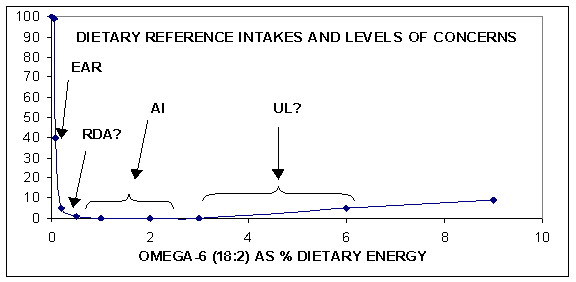 Dietary omega-6 nutrients give BOTH benefit and harm, depending on intakes (reviewed in detail in 2014).
Dietary omega-6 nutrients give BOTH benefit and harm, depending on intakes (reviewed in detail in 2014).
- EAR-Unwanted dermal signs were present in 100% infants receiving 0.04 % energy as linoleate, but in only 40% infants receiving 0.07 % energy as linoleate and not in any receiving 1.3 %. The EAR may be near 0.06 % of energy.
- RDA-Thousands of healthy infants were raised with diets containing omega-6 as 0.4 to 0.9 % energy, and calculation showed that probably less than 0.5 % energy was needed to prevent deficiency symptoms in infants. This level may meet requirements for 97% to 98% of infants.
- AI– Although not rigorously determined, intakes of omega-6 near 1 % of food energy (more than 10 times the EAR) may be adequate.
- UL-Excessive omega-6 eicosanoid actions and thrombotic deaths are more frequent when food choices give a HUFA balance with more than 50 %n-6 in HUFA. Eating n-3 nutrients helps maintain HUFA balance below 50% n-6 in HUFA.
- Quintiles of dietary intake of n-6 linoleate in the large USA MRFIT study had the following means: 2.9; 4.4; 5.5; 6.9; 10.3 en%. All quintiles were above the estimated AI near 1% noted above. Men in the four higher quintiles of omega-6 intake had higher HUFA balance (near 80% n-6 in HUFA ) and nearly twice the incidence of heart attacks as men in the lowest quintile (near 60% n-6 in HUFA). Links between dietary nutrients, HUFA balance and unwanted health conditions are important in the etiology of many well-known comorbid states.
Updated October, 2017
